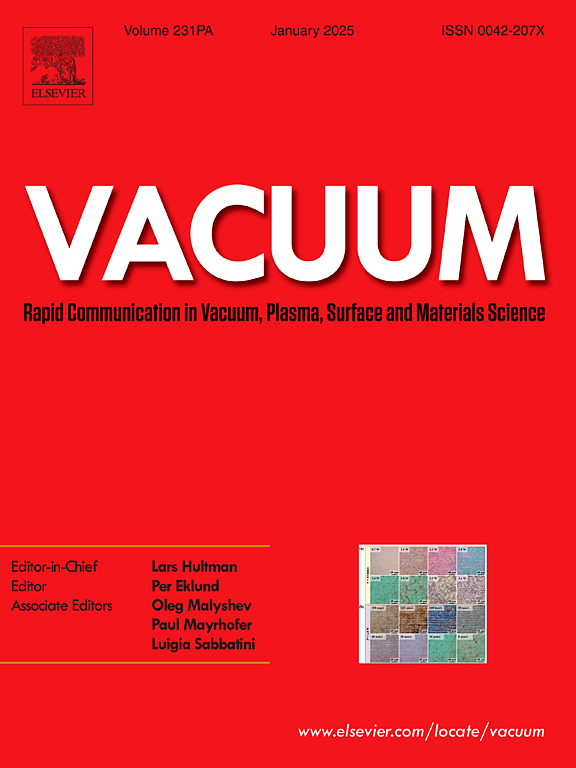Stable and high current emission of electrons from a HfC nanoneedle field-emitter fabricated by focused ion beam
IF 3.8
2区 材料科学
Q2 MATERIALS SCIENCE, MULTIDISCIPLINARY
引用次数: 0
Abstract
HfC nanoneedles with both excellent electron emission characteristics and robust structure are promising field-emission point electron sources, especially for applications desiring a high emission current. Herewith we report successful fabrication of HfC nanoneedle emitter by focused ion beam and its characterization. Transmission electron microscopy and energy dispersive X-ray spectroscopy examinations show that the HfC nanoneedle has a sharp tip with a radius of curvature of about 10 nm. Its atomic structure remains crystalline and it is aligned in a <100> direction. The HfC nanoneedle emitter has a low work function of 3.2 eV. It delivers an electron beam with a low turn-on field of 2.7 V/nm (at emission current of 2 nA) and a threshold field of 3.5 V/nm (at emission current of 50 nA), respectively. The HfC nanoneedle emitter also exhibits an excellent emission stability with a fluctuation of 1.5 % in 15 min under a high current (280 nA). The excellent current stability is attributed to the sharp tip lowering the extraction voltage that reduced ion bombardment and oxidation of the emitter surface with lowered activities in gas adsorption or desorption.
聚焦离子束制备的氢氟碳化物纳米针场发射极的稳定和高电流发射电子
氢氟碳化物纳米针具有优异的电子发射特性和坚固的结构,是很有前途的场致发射点电子源,特别是在需要高发射电流的应用中。本文报道了利用聚焦离子束成功制备氢氟碳化物纳米针发射器及其表征。透射电子显微镜和能量色散x射线能谱检测表明,HfC纳米针具有一个曲率半径约为10 nm的尖锐尖端。它的原子结构仍然是晶体状的,排列成<;100>;方向。HfC纳米针发射极的功函数较低,为3.2 eV。输出的电子束低导通场为2.7 V/nm(发射电流为2na),阈值场为3.5 V/nm(发射电流为50na)。在高电流(280 nA)下,HfC纳米针发射极在15 min内具有1.5%的发射稳定性。优异的电流稳定性归因于尖头降低了萃取电压,减少了离子轰击和发射极表面的氧化,降低了气体吸附或解吸活性。
本文章由计算机程序翻译,如有差异,请以英文原文为准。
求助全文
约1分钟内获得全文
求助全文
来源期刊

Vacuum
工程技术-材料科学:综合
CiteScore
6.80
自引率
17.50%
发文量
0
审稿时长
34 days
期刊介绍:
Vacuum is an international rapid publications journal with a focus on short communication. All papers are peer-reviewed, with the review process for short communication geared towards very fast turnaround times. The journal also published full research papers, thematic issues and selected papers from leading conferences.
A report in Vacuum should represent a major advance in an area that involves a controlled environment at pressures of one atmosphere or below.
The scope of the journal includes:
1. Vacuum; original developments in vacuum pumping and instrumentation, vacuum measurement, vacuum gas dynamics, gas-surface interactions, surface treatment for UHV applications and low outgassing, vacuum melting, sintering, and vacuum metrology. Technology and solutions for large-scale facilities (e.g., particle accelerators and fusion devices). New instrumentation ( e.g., detectors and electron microscopes).
2. Plasma science; advances in PVD, CVD, plasma-assisted CVD, ion sources, deposition processes and analysis.
3. Surface science; surface engineering, surface chemistry, surface analysis, crystal growth, ion-surface interactions and etching, nanometer-scale processing, surface modification.
4. Materials science; novel functional or structural materials. Metals, ceramics, and polymers. Experiments, simulations, and modelling for understanding structure-property relationships. Thin films and coatings. Nanostructures and ion implantation.
 求助内容:
求助内容: 应助结果提醒方式:
应助结果提醒方式:


